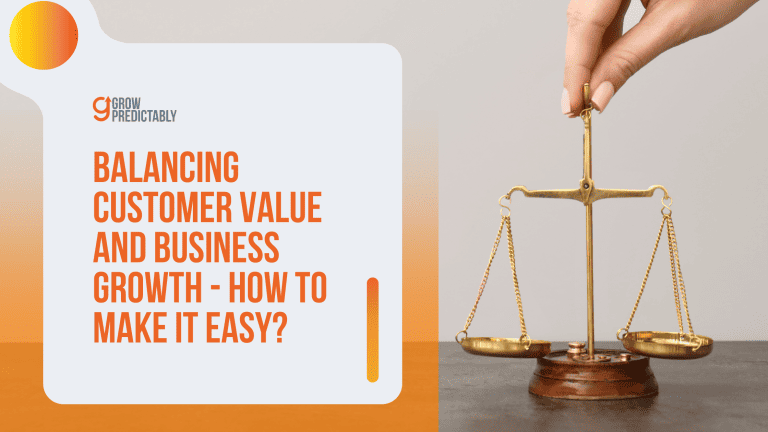The Importance of Customer Avatar in Marketing – Success in Resonating with Your Audience
Are you struggling to connect with your target audience as a SaaS business?
This is a common issue when SaaS businesses don’t have a clear understanding of their ideal customer.
One major mistake is assuming you know your customer without using data to back it up.
This can lead to ineffective marketing strategies that don’t resonate with your target audience at all—and you wouldn’t want that!
Don’t stress though, with a well-crafted customer avatar you can ensure your marketing efforts are well-directed and impactful.
Explore the blog to find out how to create a customer avatar and overcome the obstacles that are holding your marketing back.
Read on to discover the steps needed to craft an effective customer avatar and the mistakes you need to avoid for maximum impact.
- A customer avatar is a detailed profile of your ideal customer. It includes demographic details, interests, behaviors, needs, and goals, and it’s created using real data rather than assumptions.
- Regularly refining your customer avatar is crucial. This can be done by collecting ongoing feedback, monitoring market trends, and conducting regular reviews.
- Common mistakes to avoid when creating a customer avatar include making assumptions instead of using data, creating too many avatars, ignoring customer pain points, failing to update the avatar, and not using the avatar in marketing efforts.
- Understanding your customer avatar can greatly influence product development, from identifying needs and preferences to guiding feature development, improving user experience, and refining the product over time.
Understanding the Importance of Customer Avatar in Marketing
A customer avatar, often referred to as a buyer persona, is a detailed profile of your ideal customer or SaaS customer.
This isn’t just about demographics like age or income, but it dives deeper into aspects such as your SaaS customer’s preferences, values, and purchasing habits.
The importance of a customer avatar or a buyer persona in marketing, just like the customer value journey (CVJ), lies in its ability to guide your marketing strategy.
When you have a clear understanding of who your ideal SaaS customer is, you can tailor your marketing messages to resonate with that specific group.
This increases the likelihood of your message being received and making an impact.
Why is this so crucial? A famous line by Peter Drucker says this:
The aim of marketing is to know and understand the customer so well the product or service fits him and sells itself… The aim of marketing is to make selling superfluous.
Peter Drucker
Simply put, a customer avatar allows you to understand who your customers are, what they need, and how your product or service can fulfill those needs.
This understanding is crucial for all facets of marketing – from the development of a product to its sale.
As per Forbes, an avatar in marketing is a little fiction that helps us understand who our ideal customers are so we can more easily find them.
Without a well-defined customer avatar, you risk spending time and resources on marketing efforts that may not effectively reach your intended audience as a SaaS business.
However, with a clear customer avatar, you can focus your marketing strategies to attract and engage your ideal customers, leading to greater business success.
Benefits of Using Customer Avatars in Marketing
When I first started my journey in marketing, I found myself struggling to target the right audience and allocate resources efficiently.
Then, I discovered what having an ideal customer avatar can do for me.
This tool revolutionized my marketing efforts, enabling me to create more impactful campaigns.
There are many benefits to using customer avatars in SaaS marketing.
Let’s name the top three.
1. Creating targeted marketing campaigns
With a detailed customer avatar, I was able to understand who my ideal customer is, what they want, and how they make decisions.
This allowed me to tailor my marketing messages to speak directly to them, increasing the effectiveness of my campaigns. Instead of casting a wide net and hoping for the best, I could now aim with precision.
2. Efficient resource allocation
Prior to using a customer avatar, I was spending a lot of time and money on marketing strategies that didn’t yield the results I wanted.
But once I had a clear picture of my ideal customer, I was able to focus my efforts on strategies that actually resonated with them. This didn’t just save me resources—it boosted my return on investment significantly.
3. Improved communication
A customer avatar didn’t just improve my external communication with customers; it also enhanced internal communication within my team.
With everyone on the same page about who we were trying to reach, we were able to work together more cohesively toward our marketing goals.
Basically, a customer avatar is not just a tool—it’s a game changer for any SaaS marketer, business owner, or entrepreneur. It’s the secret weapon you need to take your marketing to the next level.
So if you’re ready to stop guessing and start growing, I highly recommend you start with creating a detailed customer avatar.
4 Steps on How to Create a Detailed Customer Avatar

Creating a detailed customer avatar is a crucial step in understanding your target audience and shaping your marketing strategies.
Using the ‘Customer Avatar Canvas’ (as seen in the image above) is the ultimate way to make this process more easier and organized.
If you want to create a customer avatar in great detail, here are steps that you need to follow.
1. Research Your Existing Customers
Start by analyzing your existing customers. Look for trends in demographics, buying behavior, interests, and challenges.
You can gather this information through surveys, interviews, or analyzing customer data.
Use analytics tools to streamline the process of gathering and analyzing customer data. Tools like Google Analytics or social media insights can provide valuable information about your audience’s demographics and behavior.
As a founder, I remember spending hours manually sifting through customer data.
Only after I started using analytics tools did I realize how much time and effort I could save.
These tools not only made it easier to gather data, but they also provided insights I would have missed otherwise.
To have a closer look at your existing customers, make use of:
- Surveys and Questionnaires: You can use surveys or questionnaires to gather information directly from your ideal customers. Ask them about their age, occupation, interests, challenges, and anything else that might be relevant to your product or service. It’s a direct and effective way to understand your customers’ needs and preferences.
- Customer Interviews: Conducting one-on-one interviews with your customers can provide deeper insights. This method allows you to ask follow-up questions and delve deeper into their responses, giving you a better understanding of your customers’ motivations and behaviors.
- Analysis of Customer Data: Utilize the data you already have about your customers. This could be data from past purchases, interactions with your website or customer service, or other touchpoints. Analyzing this data can reveal patterns and trends that help you understand your customers better.
2. Identify Trends and Patterns
Once you’ve gathered enough data, start looking for trends and patterns.
What common characteristics do your best SaaS customers share? What are their shared pain points or challenges?
Don’t ignore outliers in your data. Sometimes, they can reveal a potential market segment you hadn’t considered.
When I first started analyzing customer data, I focused mainly on the majority of trends.
Only later, when I paid attention to a small group of customers who were different from my main audience, I realized there was an untapped market segment.
This led to a new marketing strategy targeting this unique group, which turned out to be highly successful.
If you want to identify the patterns that will reveal who your real customers are, you have to:
- Analyzing Purchasing Behavior: Look at the buying habits of your customers. Do they often buy certain products together? Do they make purchases at specific times? Identifying these patterns can provide valuable insights into your customers’ preferences and needs.
- Using Analytics Tools: Tools like Google Analytics can help you spot trends in how your customers interact with your website. You can see which pages they spend the most time on, what content they engage with, and more. This data can reveal what interests your customers and what doesn’t.
- Reviewing Customer Feedback: Pay attention to what your customers are saying. Are there common complaints or praises in their reviews? Are they asking for something that you don’t currently offer? Their direct feedback can highlight trends in their experiences and expectations.
3. Create a Semi-fictional Character
Based on your research, create a semi-fictional character who represents your ideal SaaS customer.
Include details like their age, occupation, interests, challenges, goals, and buying behavior.
Give your ideal customer avatar a name and a face. It might seem silly, but it helps to humanize them and makes thinking about their needs and wants more intuitive.
I found that naming the avatar for my ideal customer and even choosing a stock photo to represent them made a big difference.
It made them feel more real, and it was easier to keep them in mind when making decisions about product development or marketing strategies.
If you’re ready to bring form to your customer’s character, try:
- Combining Customer Data: Combine the common traits and trends you’ve identified in your customer research to create a composite character. This character should represent the average or ideal customer based on the data you have.
- Adding Personal Details: Make this character more relatable by adding personal details. These could include a name, a backstory, hobbies, and family details. While these details might not directly impact their purchasing decisions, they help to humanize the avatar for your ideal customer and make it easier to keep them in mind.
- Including Preferences and Challenges: Ensure that you include details about this character’s preferences and challenges related to your product or service. What do they like about it? What problems does it solve for them? These details will help guide your marketing strategies and product development.
4. Refine Your Avatar Over Time
Your customer avatar should not be static.
As you learn more about your customers and your business evolves, refine your avatar to keep it accurate.
Regularly revisit and update your customer avatar. Consider setting a reminder to review it every few months.
In my experience, continually updating the customer avatar has been key in keeping our marketing strategies effective. Why?
Because as our product evolved, so did our customers.
Regular reviews of our customer avatar allowed us to stay in tune with our audience’s changing needs and preferences.
To refine your customer avatars, you must:
- Collect Ongoing Feedback: Regularly ask for feedback from your ideal customer on your products, services, and experiences. This can help you identify any changes in their needs or preferences, allowing you to adjust your customer avatar accordingly.
- Monitor Market Trends: Keep an eye on broader market trends and shifts in your industry. Changes in technology, consumer behavior, or market dynamics could impact your ideal customer profile, so update your avatar to reflect these changes.
- Regular Reviews: Set a schedule to review and update your customer avatar regularly, perhaps every quarter or twice a year. As your business evolves and grows, your ideal customer will likely evolve, too, so make sure your avatar stays up-to-date.
All-in-all, a well-defined customer avatar can be instrumental in guiding your SaaS marketing strategies and ensuring they resonate with your target audience.
Take the time to create and refine your customer avatar—it’s worth the effort!
Ready to create your ideal SaaS customer avatar? Download your copy of the ‘Customer Avatar Canvas’ here now!
Successful Customer Avatars in SaaS Marketing – Slack
Effective customer avatars help brands laser-target their customers.
And for some of the global SaaS brands that we all know, these avatars have become big factors in billion-dollar successes.
Let’s look at Slack, a popular SaaS company that offers messaging and collaboration tools for teams.

Slack’s ideal target audience includes small to medium-sized businesses, remote teams, and large enterprises looking to improve communication.
Their typical users are tech-savvy professionals who need seamless, real-time communication tools to enhance productivity.
These users value efficiency and integration with other tools they use daily, such as Google Drive, Trello, and Zoom.
Slack users often work in fast-paced environments where quick decision-making and collaboration are crucial.

They appreciate Slack’s user-friendly interface, which allows them to create channels for different projects or departments, making it easier to organize conversations.
Moreover, Slack’s target audience includes managers and team leaders who prioritize fostering a collaborative and transparent work culture.
These individuals are looking for ways to reduce email clutter and streamline communication.
By understanding these specific needs and preferences, Slack can tailor its marketing messages to resonate with potential users, highlighting features that address their pain points and improve their workflow.
5 Common Mistakes to Avoid When Creating Customer Avatars

Creating a customer avatar is a strategic process that requires careful thought and planning.
But be careful, it’s easy to fall into certain traps.
Here are some common mistakes to avoid when creating a customer avatar:
1. Making Assumptions Instead of Using Data
One of the biggest mistakes businesses make is creating a customer avatar based on assumptions rather than data.
Remember, your customer avatar should be based on real, tangible data about your existing SaaS customers.
So, instead of guessing who your ideal customer is, use tools like surveys, interviews, and data analysis to gather accurate information.
2. Creating Too Many Avatars
While it’s important to account for the diversity within your customer base, creating too many avatars can dilute your marketing efforts.
Slow it down.
It’s better to focus on a few key avatars that represent the majority of your customers.
If you spread yourself too thin, your messaging may become unclear and ineffective.
3. Ignoring the Customer’s Pain Points
Your customer avatar isn’t just about demographics and buying behavior.
It’s also about understanding your customers’ problems and challenges.
If you ignore these pain points, you’ll miss out on opportunities to show how your product or service can solve these issues.
4. Failing to Update the Avatar
Markets and consumers change over time.
If you create a customer avatar but never update it, it may become outdated and no longer represent your ideal SaaS customer.
Make sure to review and revise your avatar to keep it relevant regularly.
5. Not Using the Avatar in Marketing Decisions
Finally, the whole point of creating a customer avatar is to use it in your marketing decisions.
If you create an avatar but then don’t use it to guide your SaaS marketing strategy, you’ve wasted your effort.
Always keep your avatar in mind when planning your marketing campaigns.
In short, creating a customer avatar is a crucial step towards understanding your customers and tailoring your products and services to their needs. Avoid these common pitfalls to ensure you create an effective and useful avatar.
How a Customer Avatar Influences Product Development
Understanding your customer avatar is a crucial part of product development and refinement. Here’s how it influences the process:
Identifying Needs and Preferences
The first step in any product development process is to identify what your customers need and prefer. By understanding your customer avatar, you gain insights into their pain points, preferences, and desires.
Guiding Feature Development
Once you’ve identified your customers’ needs, you can start to develop features that address these needs. Your customer avatar can help you prioritize which features to develop based on what will provide the most value to your customers.
Improving User Experience
By knowing who your customers are, how they think, and what they value, you can design an experience that resonates with them and meets their expectations.
Refining the Product Over Time
Your customer avatar isn’t static. As you gather more data and feedback from your customers, you should refine your avatar. This, in turn, can lead to further product refinements.
Enhancing Marketing and Sales Efforts
Your customer avatar can help enhance your marketing and sales efforts. When you understand who your customer is, you can create more targeted, effective marketing campaigns.
FAQs
Key Takeaways
Getting the importance of customer avatars in marketing is a game changer for any SaaS business trying to connect with its audience.
Think of a customer avatar as a super detailed profile of your ideal customer that goes way beyond age and income.
It dives into their interests, behaviors, and needs.
This blog shows how creating and regularly updating your customer avatar can help you craft spot-on marketing campaigns, save resources, and improve communication both inside and outside your team.
By basing your customer avatar on real data, you can dodge common mistakes like making assumptions, creating too many avatars, and missing out on customer pain points.
This focused approach ensures your marketing actually hits home, leading to better results and happier customers.
Plus, the blog highlights how knowing your customer avatar can majorly impact product development.
In short, spending time on creating a detailed customer avatar can totally revamp your SaaS marketing and product strategies, helping you connect better with your audience and grow your business.
Ready to make a difference? Start working on your customer avatar today and watch your marketing efforts pay off.
For more tips on digital marketing, business, and mindset, check out our other blogs. There’s plenty more value to unlock and ways to boost your business!








